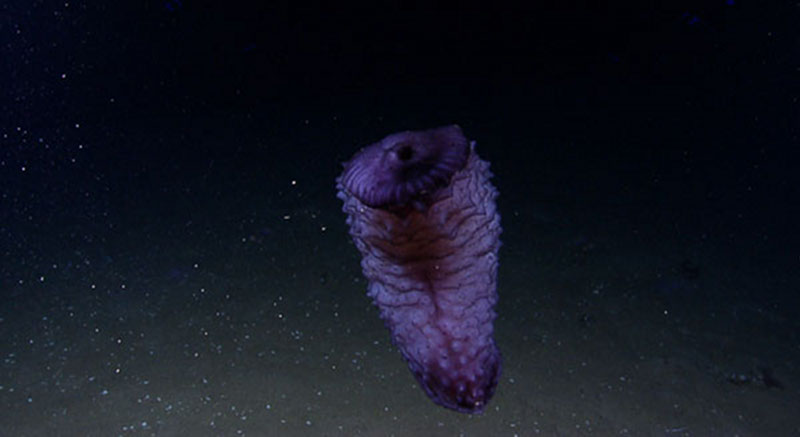
By Robert S. Carney, Professor of Oceanography - Louisiana State University
April 24, 2012
When the Little Hercules remotely operated vehicle (ROV) gets a great close-up video portrait of a deep coral, the pilots onboard the Okeanos Explorer have to carry out a technically challenging feat. They have to adjust the density of the vehicle to be the same as the surrounding seawater. If density is too low, the vehicle will be forced up by buoyancy. If the density is too high, buoyancy will not be enough to overcome gravity and the vehicle will sink.

A view of the escape swimmer Benthothuria, flexing so strongly that the mouth has been brought into view. Image courtesy of the NOAA Office of Ocean Exploration and Research, Gulf of Mexico Expedition 2012. Download larger version (jpg, 1.1 MB).
During our exploration we have encountered deep-sea holothuroids, also known as “sea cucumbers,” which can manage this buoyancy task remarkably well. So well that we have to ask: How do they do it?
Cruising over a deep mud bottom, Little Hercules has encountered quite a variety of holothuroids. Some do what holothuroids were thought to be doing—living a very slow-paced life, consuming the top layer of sediment, digesting what little nutrition may have survived the slow sinking from the productive upper ocean and leaving fecal castings behind. It probably isn't an exaggeration to say that all deep-ocean sediments have probably been through the intestine of a holothuroid many times.
Not all holothuroids live up to the old stereotype. Some species show a common escape behavior of thrusting themselves up off the bottom with a strong flexing of the body that continues rhythmically in a swimming fashion. We have seen this most dramatically with the large blue-purple animal of the genus Benthothuria.
When disturbed, Benthothuria gracefully thrusts its colorful body upward, defecates and then it floats! Just like a manned submersible dropping ballast, the animal eliminates enough of the heavy sediment to become neutrally buoyant. Now we face our unanswered question ... how does it get back down? Or, how does it get heavy again?
During early deep-ocean explorations, holothuroids that were so gelatinous that they resembled jellyfish were caught in trawls that never reached bottom. Previous NOAA exploration in the Gulf of Mexico allowed observation of the behavior of one of these, the genus Enypniastes. This graceful purple swimmer seems to spend most of the time a few meters above bottom. However, it does not feed there. Rather, it drops from a neutrally buoyant "hover" to the bottom and rapidly shovels sediment into the mouth with a ring of feeding tentacles. When finished or disturbed, it makes a strong push with a large fin-like structure and swims away, eventually becoming neutral again and drifting until the next feeding trip to the bottom.
During the current exploration, we have encountered another master of buoyancy, which we will refer to as the genus Scotoanassa. A distinct relative of Enypniastes, Scotoanassa has an identical life style. It spends most of its time hovering a few meters above the seafloor until it drops to the bottom, swallows a gut full of mud, and swims up to drift along again.
Pulling a few observations together we find an interesting question. Buoyancy control is a critical engineering challenge in ROVs, human-occupied vehicles (HOV), autonomous underwater vehicles, military submarines, Scotoplanes and Enypniastes. Maybe there is a lesson to be learned from the last two?
Using specimens freshly caught by the HOV Alvin and the ROV Jason during previous cruises, a very curious observation was made. Enyniastes and Scotoanassa both float to the surface when placed in shipboard aquaria if the gut is devoid of all ingested mud. This is easy to see since the animal and the gut are transparent. If there is mud remaining in the gut, they are either neutral or slowly sink to the bottom. So, the body density of both species is due to a combination of heavy mud plus the low-density gel of the body wall. But that is only part of it.
What happens when digestion is finished and the mud evacuated from the drifting animal ... does it float uncontrolled to the surface? No, its body somehow gets heavy again without mud, drops to bottom, and fills up with mud again. It would seem to have active density control of its tissues.
Is there a connection between the ability of many echinoderms to control the elasticity of their connective tissue and these bentho-pelagic dancers to alter density? These questions remain unanswered.